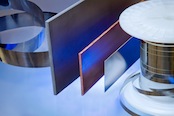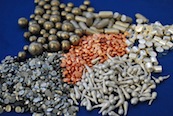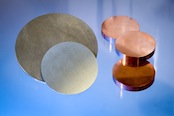Nickel Silicide NiSi2
MATERIAL SAFETY DATA SHEET
I. PRODUCT IDENTIFICATION
Manufacturer/Supplier:
ESPI Metals
1050 Benson Way, Ashland, OR 97520
Toll Free (800) 638-2581 * Fax (541) 488-8313
E-Mail: This email address is being protected from spambots. You need JavaScript enabled to view it.
Product Name: Nickel Silicide
Formula: NiSi2
CAS Number: 12201-89-7
II. HAZARDOUS INGREDIENTS
Hazardous Component: Nickel Silicide
Percent (%): 0-100
OSHA/PEL: 1 mg(Ni)/m3
ACGIH/TLV: 0.2 mg(Ni)/m3
HMIS Rating:
Health: 2
Flammability: 0
Reactivity: 0
III. PHYSICAL DATA
Boiling Point: N/E
Melting Point: N/E
Specific Gravity: N/E
Solubility in H2O: Insoluble
Appearance and Odor: Gray powder or pieces, no odor.
IV. FIRE AND EXPLOSION HAZARDS DATA
Flash Point: N/A
Flammability: Non-flammable
Autoignition Temperature: N/A
Explosive Limits: Upper: N/A Lower: N/A
Extinguishing Media: Use suitable extinguishing media for surrounding material and type of fire.
Special Firefighting Procedures: Firefighters must wear full face, self-contained breathing apparatus and full protective clothing to prevent contact with skin and eyes.
Unusual Fire & Explosion Hazard: When heated to decomposition nickel silicide may emit toxic metal oxide fumes.
V. HEALTH HAZARD INFORMATION
Effects of Exposure:
To the best of our knowledge the chemical, physical and toxicological properties of nickel silicide have not been thoroughly investigated and recorded.
Nickel is a confirmed carcinogen with experimental carcinogenic, neoplastigenic, tumorigenic and teratogenic data, and is a poison by ingestion, intratracheal, intraperitoneal, subcutaneous and intravenous routes. An experimental teratogen. Ingestion of soluble salts causes nausea, vomiting and diarrhea. Hypersensitivity to nickel is common and can cause allergic contact dermatitis, pulmonary asthma, conjunctivitis and inflammatory reactions around nickel-containing medical implants and prosthesis. Cancer develops in rodents after administration of Ni3S2, NiO or Ni (Co4). Pulmonary damage develops in rodents chronically exposed to aerosols of nickel dust, NiO2 or NiO. (Sax, Dangerous Properties of Industrial Materials, eighth edition.)
Inorganic silicon compounds may be acute inhalation irritants. Prolonged inhalation may cause pulmonary fibrosis known as silicosis.
Acute Effects:
Inhalation: May cause irritation to the upper respiratory tract, mucous membranes and nasal cavities. May cause pulmonary asthma attacks.
Ingestion: Nickel is poison by ingestion. Large doses may cause intestinal disorders, convulsions and asphyxia.
Skin: May cause irritation.
Eye: May cause irritation.
Chronic Effects:
Inhalation: Prolonged or repeated inhalation may cause pneumonitis.
Ingestion: May cause nickel toxicity.
Skin: May sensitize the skin (nickel itch). May cause allergic dermatitis, eczematous dermatitis and may be accompanied a week later with superficial skin ulcers, which may discharge and become crusted.
Eye: May cause conjunctivitis.
Target Organs: May affect the nasal cavities, respiratory system, lungs, blood and skin.
Medical Conditions Generally Aggravated by Exposure: Pre-existing respiratory disorders, pulmonary functions, asthma and skin disorders.
Carcinogenicity: NTP: Yes IARC: Yes OSHA: Yes
EMERGENCY AND FIRST AID PROCEDURES:
INHALATION: Remove victim to fresh air, keep warm and quiet, give oxygen if breathing is difficult and seek medical attention.
INGESTION: Give 1-2 glasses of milk or water and induce vomiting, seek medical attention immediately. Never induce vomiting or give anything by mouth to an unconscious person.
SKIN: Remove contaminated clothing, brush material off skin, wash affected area with mild soap and water, seek medical attention if symptoms persist.
EYE: Flush eyes with lukewarm water, lifting upper and lower eyelids, for at least 15 minutes. Seek medical attention if symptoms persist.
VI. REACTIVITY DATA
Stability: Stable
Conditions to Avoid: None.
Incompatibility (Material to Avoid): None
Hazardous Decomposition Products: Metal oxide fume
Hazardous Polymerization: Will not occur.
VII. SPILL OR LEAK PROCEDURES
Steps to Be Taken in Case Material Is Released or Spilled: Wear appropriate respiratory and protective equipment specified in section VIII. Isolate spill area and provide ventilation. Sweep or scoop up or vacuum up spill using a high efficiency particulate absolute (HEPA) air filter and place in a closed container for proper disposal. Take care not to raise dust.
Waste Disposal Method: Dispose of in accordance with Local, State and Federal regulations.
VIII. SPECIAL PROTECTION INFORMATION
Respiratory Protection: NIOSH approved respirator.
Ventilation: Use local exhaust to maintain concentration at or below the PEL, TLV. Handle in a controlled environment when in dust or powder form. General exhaust is not recommended.
Protective Gloves: Rubber gloves.
Eye Protection: Safety glasses.
Other Protective Clothing or Equipment: Protective gear suitable to prevent contamination.
IX. SPECIAL PRECAUTIONS
Precautions to Be Taken in Handling and Storage: Store in a tightly sealed container in a cool, dry area. Wash thoroughly after handling.
Work Practices: Implement engineering and work practice controls to reduce and maintain concentration of exposure at low levels. Use good housekeeping and sanitation practices. Do not use tobacco or food in work area. Wash thoroughly before eating and smoking. Do not blow dust off clothing or skin with compressed air. Maintain eyewash capable of sustained flushing, safety drench shower and facilities for washing.
TSCA Listed: Yes
DOT Regulations:
Hazard Class: None
The above information is believed to be correct, but does not purport to be all inclusive and shall be used only as a guide. ESPI shall not be held liable for any damage resulting from handling or from contact with the above product.
Issued by: S. Dierks
Revised/Verified: May 2008

 ALLOYS
ALLOYS 





